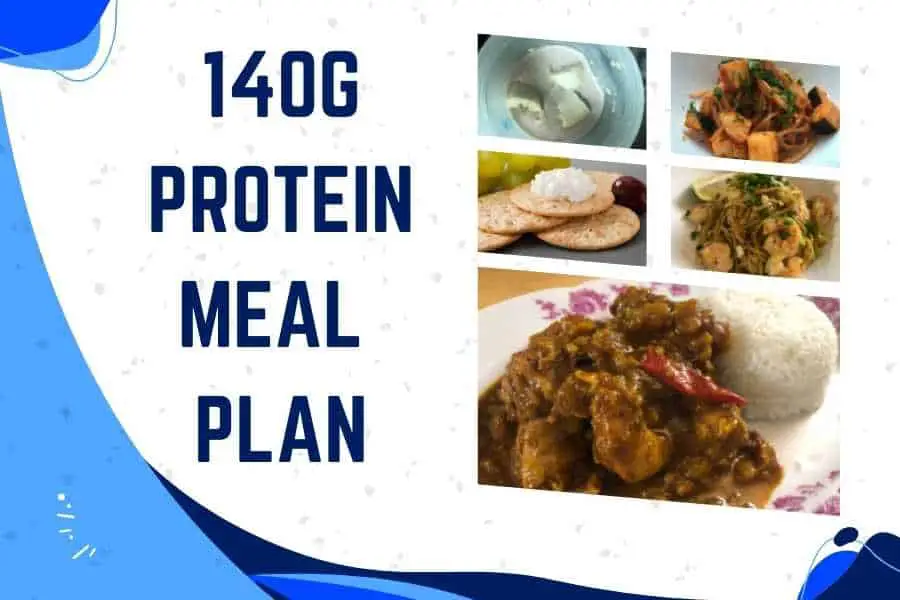Learning how to effectively switch to a high-protein diet can be confusing; especially for beginners who’ve never tried it before. In this article, I’ll show you how to eat 140g of protein in a single day without feeling bloated or overconsuming calories.
A protein-rich meal should be eaten 3-6 times a day to reach a 140g daily intake. High-protein foods include lean beef cuts, fresh fish, shellfish, egg whites, poultry, and protein powders. Vegetarian options include whole grains, legumes, pulses, and soy derivatives.
Here are some mistakes that I made as a newbie that you may want to avoid:
- Eating too much fatty meat cuts which can add excess calories and promote fat gain.
- Not including plant protein sources (these are often packed with the leanest protein).
- Not realizing that carbs often contain plant protein.
- Thinking you need to eat dry chicken breast all day every day (does anyone actually enjoy that?!).
Speaking from experience, it’s not difficult to increase your protein intake in a healthy and delicious way. But it’s essential to plan your meals in advance (I got you covered with my meal plans!).
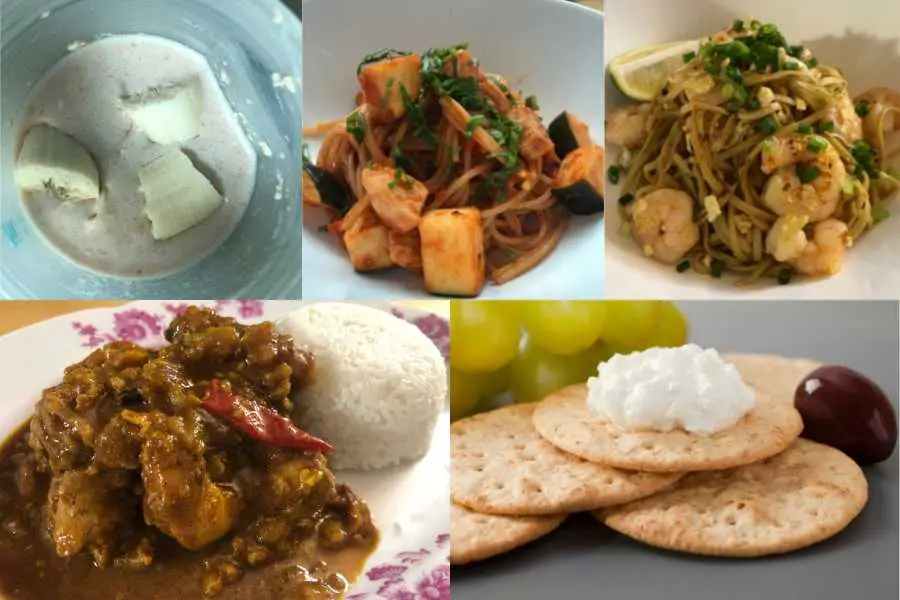
Here’s my meal plan- the 5 meals are easy to cook, delicious, costs under 20 bucks, and provide 140g of total protein!
Reasons For Eating 140g Of Protein Per Day
First, let’s briefly cover the main reasons for consuming so much protein.
If you’re reading this article, then chances are you’re interested in one of the following three goals:
- Increasing lean muscle mass. Protein is the building block for muscle. Therefore eating sufficient quantities of this macronutrient is key for anyone looking to get bigger and stronger. In fact, this 2000 scientific paper recommends an intake between 1.6-1.8g per kg (0.7-0.8g per lb) of body weight to maximize muscle gains.
- Losing excess body fat. The results of this 2020 study indicate protein can reduce hunger and keep you satiated for longer. Additionally, it also helps to preserve muscle mass for a toned body as you lose weight.
- Both of the above. This 2016 study recommends increasing protein intake to maximize muscle gains and minimize fat gains.
Therefore, eating enough of this essential nutrient can help you to get in shape by increasing muscle mass.
And assuming the average person (male and female) weighs approximately 150-200lbs, then a high-protein diet falls close to eating ~140g each day!
Next, I’ll show you how I do it.
Important Note:
Most people will find that eating 140g of protein a day is sufficient to build muscle. But only if it is combined with a heavy resistance training program.
If you’re interested, you can find my 3-day home workout here.
Meal Plan To Get 140g Of Protein A Day
Overview:
You’ll find below an example of what I eat throughout the day to get 140 grams of protein. Each meal contains just under 30g of protein. I also detail the total nutritional content, including calories.
| Meal | Protein | Calories | Cost (USD) |
|---|---|---|---|
| Oatmeal Fruit Shake | 29g | 370 cal | $2.50 |
| Chicken Arrabiata Pasta | 27g | 408 cal | $3.50 |
| Shrimp Chilli Lime Stir Fry | 25g | 350 cal | $4.50 |
| Beef Curry With Rice | 31g | 819 cal | $4.50 |
| Cottage Cheese Wheat Crackers | 28g | 225 cal | $3.50 |
| Total: | 140g | 2172 cal | $18.50 |
Here’s why I like this meal plan:
- 5 meal frequency. The body can only take in a limited amount of protein per meal. Therefore consuming multiple meals throughout the day will help you to actually absorb what you eat. Additionally, spacing total protein intake throughout the day can reduce feelings of bloatedness. Besides, it’s not 5 full-blown meals either. Some meals are simply protein-rich snacks that are quick and easy to make. Feel free to combine the 5 meals into 4 or 3, if you prefer.
- Low to moderate calories. This prevents excess fat gains as a consequence of increasing daily protein intake.
- Incorporates animal and vegetarian ingredients. Not only is this important for a balanced diet, but plant protein is usually low in fat and high in protein!
- Convenient to prepare. These meals can be cooked in bulk on a Sunday and batched for the week. They can also be taken into the office and microwaved to heat up.
- Cheap to make. The ingredients for each meal can be bought for less than US$5.00.
- Easy to adjust for vegetarians- simply replace the protein with your preferred plant alternative.
- Flexible ingredients- don’t like chicken? Use beef! Don’t like beef? Use pork! You get the point…
1) Breakfast- Oatmeal Fruit Shake
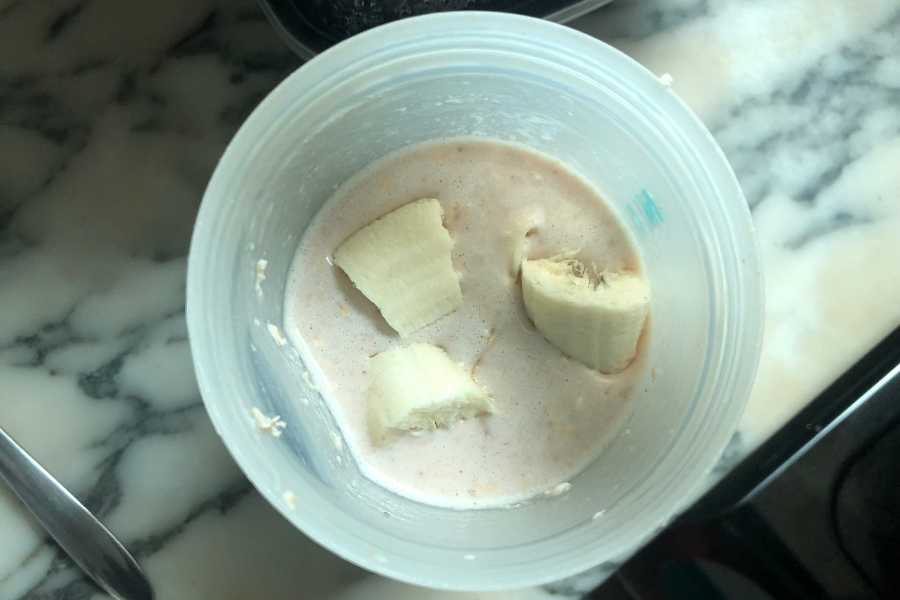
| Ingredient | Protein | Calories |
|---|---|---|
| 50g instant oatmeal | 6g | 180 cal |
| 100ml unsweetened soy milk | 3g | 40 cal |
| 1 scoop lean whey protein | 20g | 100 cal |
| 100g fresh fruit or berries | 0g | 50 cal |
| Total: | 29g | 370 cal |
Why I like it:
Oats are one of the easiest and cheapest high-protein meals you can make. Blend the oats or simply mix them in a protein shaker. I find liquid meals easy to consume and don’t give you a bloated feeling afterward.
An oatmeal shake also tastes delicious with your preferred choice of fruit. And it goes well with most protein powder flavors to make a creamy, sweet, and fruity breakfast.
Skinny people looking to bulk up fast can check out my homemade mass gainers that pack an even greater protein and calorie punch.
Top tip:
Use instant oatmeal rather than rolled or quick-cook oats. Instant oatmeal is softer and easier to consume out of the box compared to the latter two (which require cooking to soften).
2) First Lunch- Chicken Arrabiata Pasta
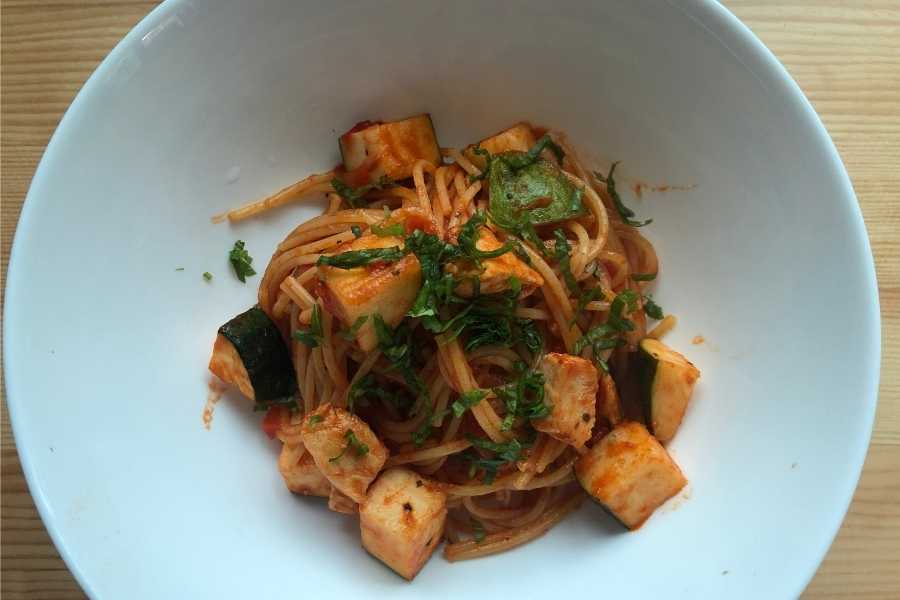
| Ingredient | Protein | Calories |
|---|---|---|
| 100g wholewheat pasta | 12g | 180 cal |
| 60g chicken thigh | 15g | 108 cal |
| 100g zucchini | 0g | 50 cal |
| 120g serving of jarred tomato sauce | 0g | 60 cal |
| Chilli flakes and/or herbs | 0g | 0 cal |
| 1-second spray of frying oil | 0g | 10 cal |
| Total: | 27g | 408 cal |
Why I like it:
As with most people, I generally enjoy pasta dishes. The arrabbiata is easy to make and tastes delicious.
Don’t forget that 100g of pasta alone contains 12g of plant protein, making it a welcome contribution to your 140g daily target.
Top tip:
This is an extremely versatile dish. Switch the pasta and meat with your preferred choice. I personally enjoy chicken. But the dish also works well with pork, shellfish, and vegetarian meat substitutes. You can also supplement the meal with a small handful of sunflower seeds for an extra protein hit.
If I’m looking for a quick lunch, then I’ll swap this dish for a 2-slice wholewheat bread sandwich using 100g of grilled chicken breast.
3) Second Lunch- Shrimp Chilli Lime Stir Fry
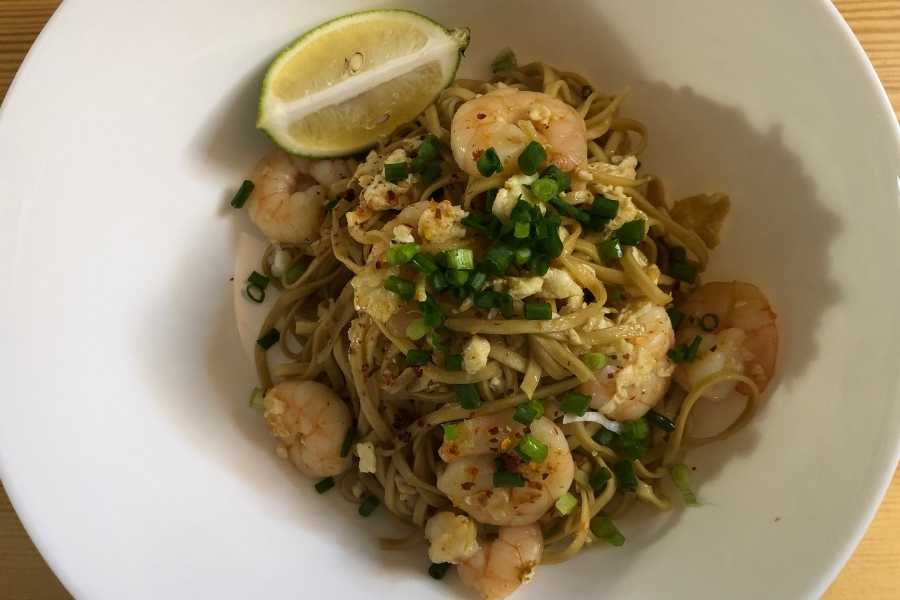
| Ingredient | Protein | Calories |
|---|---|---|
| 100g egg noodles | 7g | 250 |
| 50g fresh or frozen shrimp | 12 | 50 |
| 1 egg white | 6 | 20 cal |
| Garlic, ginger, chili, scallions, and fresh lime juice | 0g | 10 cal |
| Chicken stock, soy sauce, or salt to taste | 0g | 10 cal |
| 1-second spray of frying oil | 0g | 10 cal |
| Total: | 25g | 350 cal |
Why I like it:
This protein-packed lunch is lively, vibrant, and delicious. Just like the arrabiata above, the noodles and shrimp can be swapped with your preferred alternative. For example, you can use spaghetti instead of noodles.
It’s also very easy to make. Simply boil the noodles, rinse them with cold water, and set them aside. Then fry your shrimp, egg, and aromatics. Now add a splash of seasoning and toss in your noodles. Finally, add the lime juice and sprinkle some chopped scallion.
Top tip:
I prefer to use frozen shrimp over fresh. It’s much cheaper, easier to store, and tastes just as good in a stir fry. Additionally, the nutritional content is similar between both.
If you’re short on time, make a protein-packed sandwich with whole-grain bread! It’s not difficult to create a homemade sandwich that packs 30g of protein. And this will help you to reach that 140g a day target!
4) Dinner- Beef Curry With Rice
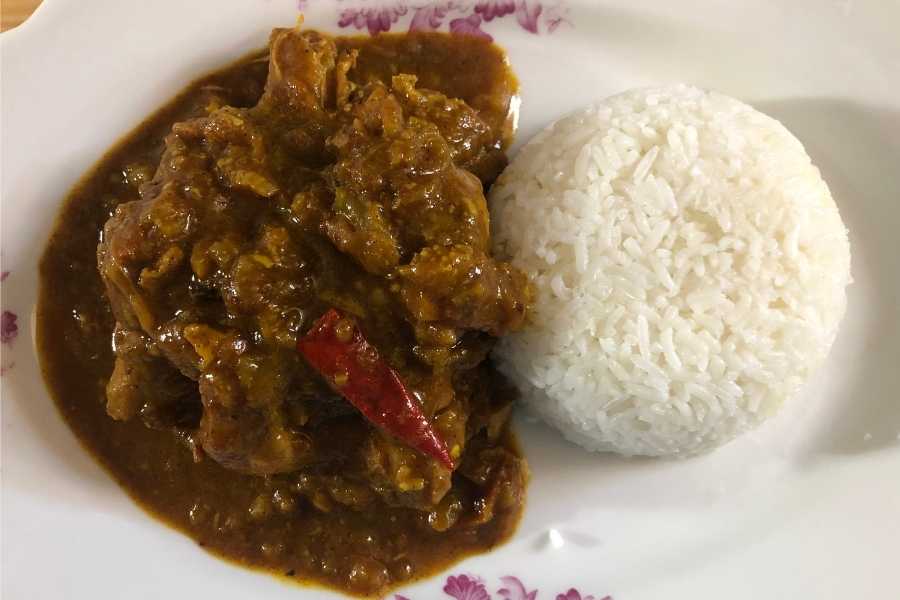
| Ingredient | Protein | Calories |
|---|---|---|
| 100g white rice | 7g | 360 cal |
| 50g lean stewing beef | 12g | 120 cal |
| 50g kidney beans | 12g | 165 cal |
| 100g fresh tomato | 0g | 50 cal |
| Chilli, cumin, paprika, garam masala, turmeric, and cinnamon powder | 0g | 10 cal |
| 1/4 white onion | 0g | 10 cal |
| 2 cloves garlic | 0g | 5 cal |
| Slice ginger | 0g | 0 cal |
| 20g Tomato puree | 0g | 5 cal |
| 1/2 beef stock cube | 0g | 10 cal |
| 2-second spray of frying oil | 0g | 20 cal |
| Total: | 31g | 819 cal |
Why I like it:
Curries and stews are one of my favorite dinners. It’s so simple to make; fry your ingredients, add stock, and simmer on low heat for a couple of hours.
The best thing about them- it’s easy to cram your preferred choice of protein to help you reach the 140g daily target.
Serve with your preferred choice of carbs, and enjoy! You can also bulk-cook a large batch and put them in the freezer!
Top tip:
Crack an egg white into the curry for a cheap way to add even more protein to this dish. Once cooked, the egg can barely be seen or tasted in the dish. But you’ll get a 6g protein boost for just ~20 calories (per egg)!
Additionally, I prefer using lean cuts (e.g. blade steaks, sirloin, stewing beef) over fatty cuts (e.g. ribeye, chuck) to minimize calories.
5) Pre-Bed Snack- Cottage Cheese Wheat Crackers
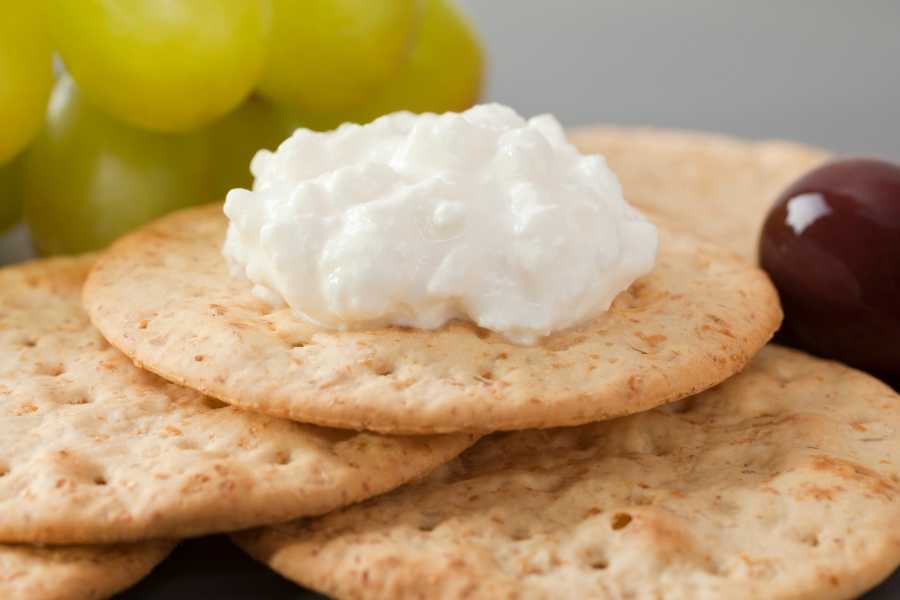
| Ingredient | Protein | Calories |
|---|---|---|
| 100g cottage cheese | 26g | 165 cal |
| 15g wheat crackers (approx 3 crackers) | 2g | 60 cal |
| Fresh herbs to taste (optional, I like to use dill) | 0g | 0 cal |
| Total: | 28g | 225 cal |
Why I like it:
This is more of a snack than a meal. But nonetheless, it will help you reach 140g of protein a day.
Cottage cheese is unique in that it contains casein which is a slow-digesting protein. This makes it ideal to eat before bed. Casein will give your muscles a steady supply of fuel. And this can facilitate muscle recovery and growth after a heavy weight workout.
Top tip:
You can have this snack at any time throughout the day. You can even choose to remove it altogether if it’s not to your taste, and instead, add an extra 100g of meat/beans to your curry/ dinner (see above).
If you’re embarking on a bulking transformation, you can go to my other post to see how long it takes to get muscular.
13 Foods That Are High In Protein
I’ve shared 5 meal plans to help you eat 140g of protein in a day. But everyone has different dietary requirements. The good news is that protein-packed foods exist whether you are a carnivore, vegetarian, or vegan!
Here are my favorites:
| Ingredient | Protein Content (per 100g) | Calories (per 100g) |
|---|---|---|
| Lean cuts of red meat | 25-30g | 250 cal |
| Ground beef | 25g | 220 cal |
| Turkey | 25g | 170 cal |
| Fresh white fish | 18g | 80 cal |
| Fresh oily fish | 20g | 150 cal |
| Shellfish | 24g | 80 cal |
| Canned tuna | 26g | 160 cal |
| Legumes and beans | 10-24g | 130 cal |
| Tofu | 8g | 75 cal |
| Nuts and seeds | 15-25g | 580 cal |
| Sweet potato | 2g | 80 cal |
| Vegan meat substitute | 25g | 150 cal |
| Wholegrains | 8-12g | 350 cal |
Average values taken from the Google database- real values may vary depending on the quality of food.
Feel free to use this list to substitute the ingredients in my meal plan as you like. For example, if you’re a vegetarian you can swap the beef for a vegan meat substitute in a curry. It will still taste great!
You may also be interested in my other article for more nutrition tips to bulk up at home as a skinny guy.
Cheapest Ways To Get 140g Of Protein
Eating 140g of protein a day can get very expensive if you’re buying premium produce. But there are also plentiful cheap options available in grocery stores.
Reggie Johal from Predator Nutrition has created an awesome list of affordable ingredients to add to your diet plan. Additionally, Stuart Marsh from Coach Nine also provides some inspiring ideas.
If you’re on a budget, you may be interested in my infographic below. I compiled 26 protein sources categorized into plant/dairy/fish/meat and ranked them according to cost.
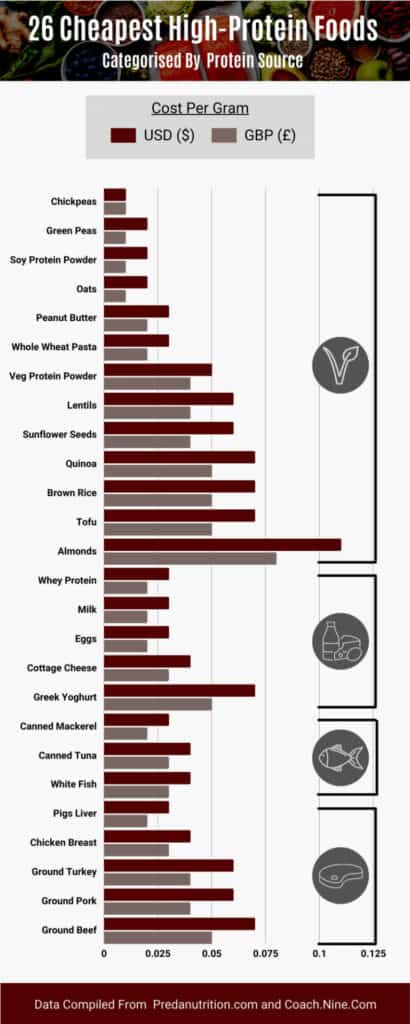
1) Fresh And Canned Fish
Fish is surprisingly cheap, averaging $0.03 per gram of protein.
As expected, canned fish such as tuna and mackerel are cheaper than fresh options. Canned tuna costs $0.04 per gram of protein. In comparison, canned mackerel is slightly cheaper at $0.03 per gram of protein.
Both can be tasty additions to a plate of pasta or rice. And you can also add your own choice of herbs, spices, and seasoning to add zest to your dishes.
White fish can also be found cheaply, averaging $0.04 per gram of protein. Examples of white fish include cod, pollock, catfish, and tilapia.
As a bonus, white fish is often low in fat and high in protein. And this makes it perfect for people looking to gain muscle with minimal fat gains.
2) Dairy
Similar to fish, dairy protein will also give you good value for money. Milk, eggs, and whey are the cheapest dairy proteins, costing $0.03 per gram of protein.
Many people overestimate the cost of whey protein. Yes, a tub may set you back around $30 (or more depending on the size). But a medium-sized tub also yields around 30-40 scoops (depending on the brand). Additionally, each scoop usually packs around 20-25g of pure protein.
Eggs and whey shakes make excellent choices for a protein-packed and cheap breakfast. If you have time in the morning, then make a 4-egg omelet for a 28g hit of protein. Or if you are running short on time, add oats to a protein shake for around 30g of protein.
Cottage cheese is slightly more expensive- coming in at $0.04 per gram of protein. But cottage cheese has a major advantage when it comes to convenience. Simply spread 100g onto wheat crackers for an easy-to-eat 12g of protein!
Greek yogurt is also a great source of protein. And you can also make a high-protein breakfast with greek yogurt, oats, and fruit. However, yogurt is slightly more expensive than the other dairy choices, costing $0.07 per gram of protein.
3) Fresh Meat
When it comes to eating protein, most people naturally think of meat. But it often comes with a high price tag. If you are savvy about your choice of cut, then you can usually find affordable meat produce in most stores.
Chicken breast is arguably one of the best choices for meat protein. It’s extremely affordable and priced at $0.04 per gram. Additionally, chicken breast is usually very lean with minimal fat. It is also a very versatile ingredient- add it to pasta, rice, or grill with potatoes!
Ground beef and pork are also fantastic sources of meat protein. Each costs $0.06 or $0.07 per gram (respectively). Ground meats are versatile ingredients that can be cooked in stews and stir-fries.
4) Vegetarian and plant
This one may come as a shock to you. But plant protein can actually be quite expensive! Of course, it depends on what kind of ingredient you go for. Some ingredients are extremely cheap, whilst other sources can be costly.
Legumes such as peas, beans, and lentils are relatively inexpensive and packed with protein. They cost between $0.01-0.06 per 100g. If you are looking for a budget legume, then nothing beats the humble chickpea. It costs a meager $0.01 per gram! And 100g packs a whopping 19g of protein! Legumes are also versatile ingredients. You can mix them into a salad or add them to stews. Alternatively, make a chickpea soup!
Quinoa, brown rice, and tofu are slightly more expensive choices for plant protein. They will set you back $0.07 per gram.
Nuts and seeds are known for their high protein content. But if you are on a budget, you should choose carefully. That’s because the prices vary greatly between different nuts and seeds. For example- sunflower seeds are a modest $0.06 per gram. But almonds come with a much higher price of $0.11 per gram! That’s almost double the price!
Vegetarian and soy protein powders are also an affordable and great way to increase protein intake for non-meat eaters. But again, budget hunters should choose their powders wisely. Both protein powders are moderately priced. However, vegetarian protein is on average more than double the price of soy protein ($0.05 vs $0.02 per gram of protein respectively).
Conclusion
Whether you’re trying to build muscle, lose fat, or both, it’s essential to eat enough protein to achieve your goals.
I’ve shared how I eat 140g of protein a day by spreading it over 5 delicious meals (each containing ~28g). You can follow the meal plan to reach your daily target with relative ease.
Remember- a meal doesn’t have to be a full-blown one. A protein-rich snack also counts as a meal.
Feel free to try the 5 meals which I detail in this article. And I encourage you to swap the ingredients to your personal tastes!
You may also be interested in the downloadable Kalibre Blueprint PDF which details exactly how I gained 40lbs of lean muscle (it’s 100% free!). It details the exact exercises and nutrition (with printables) I used to go from skinny to ripped!

